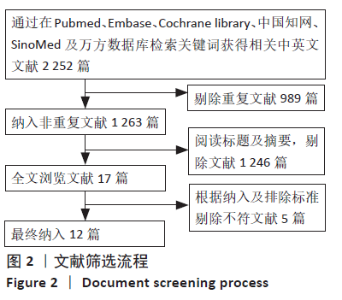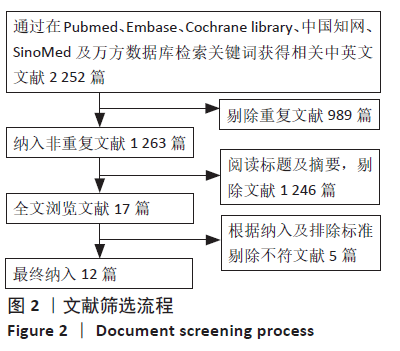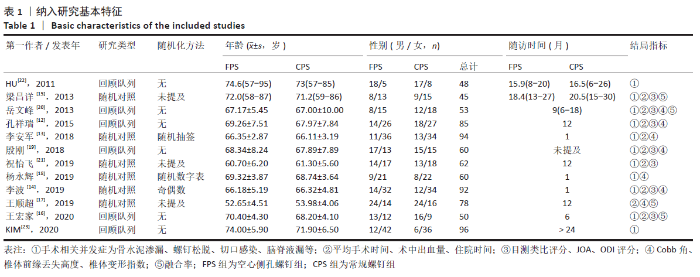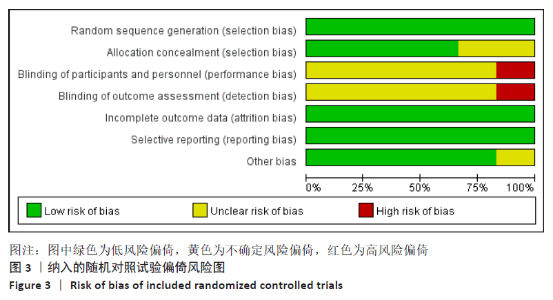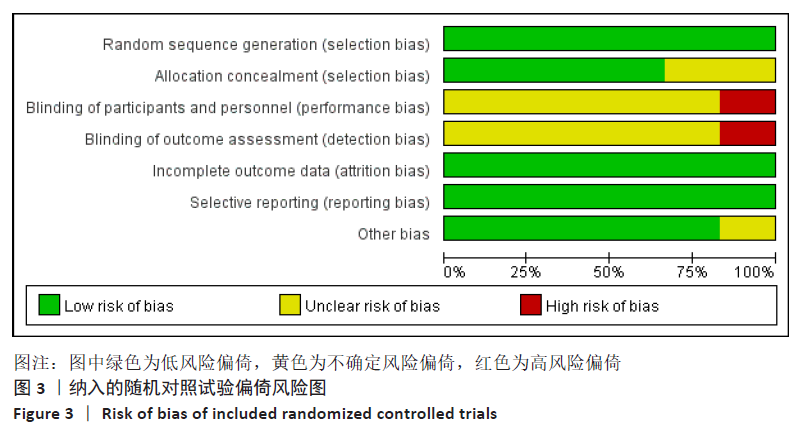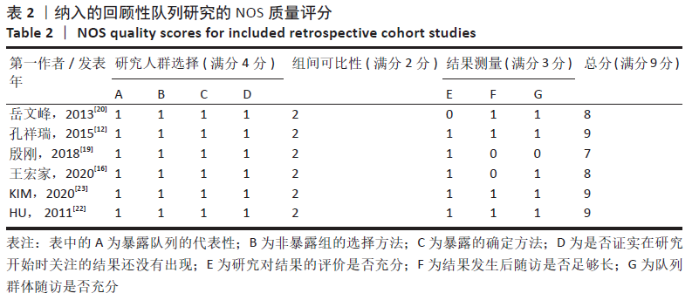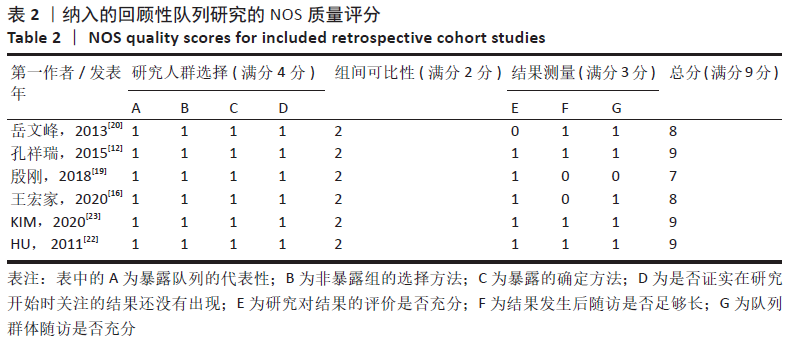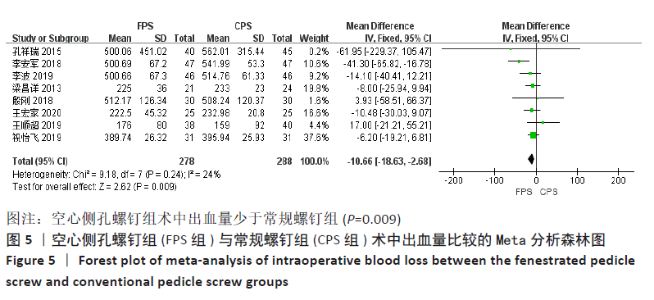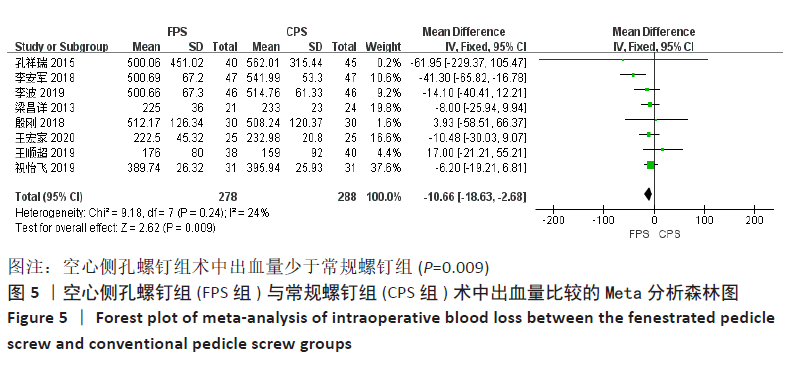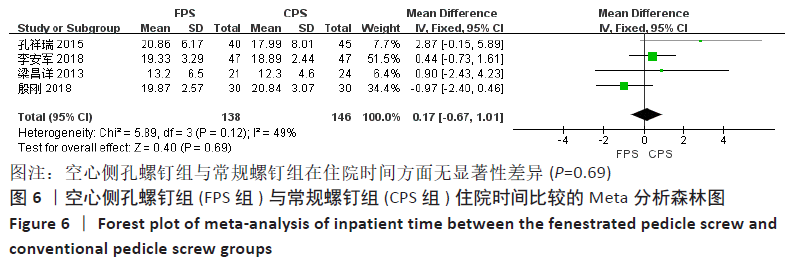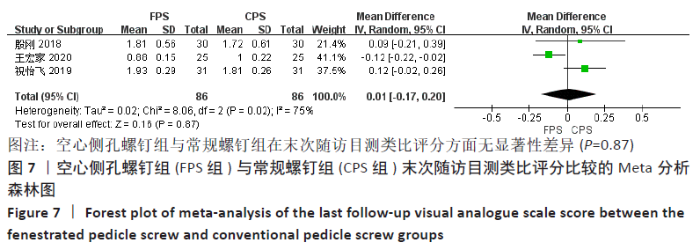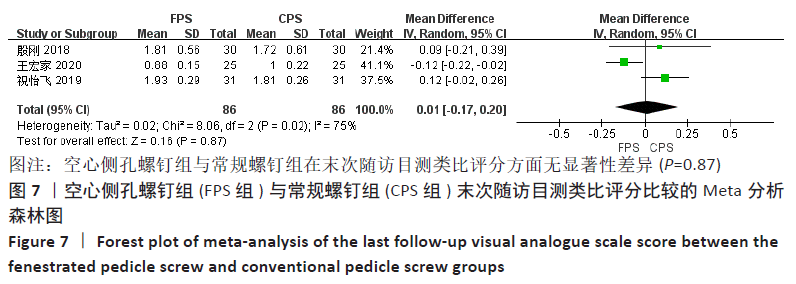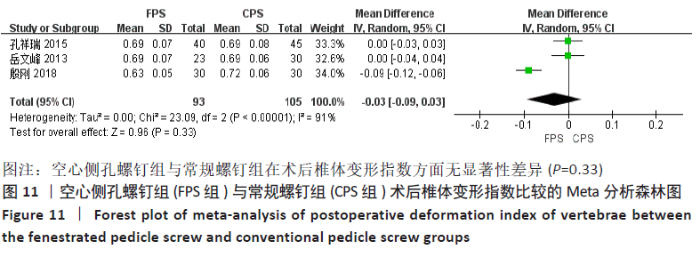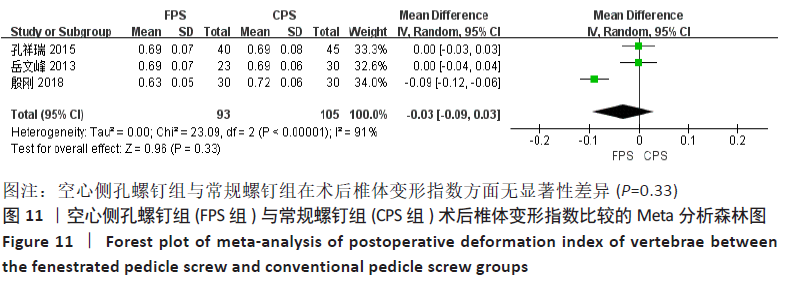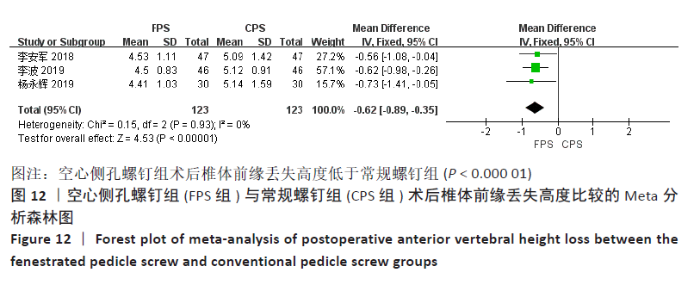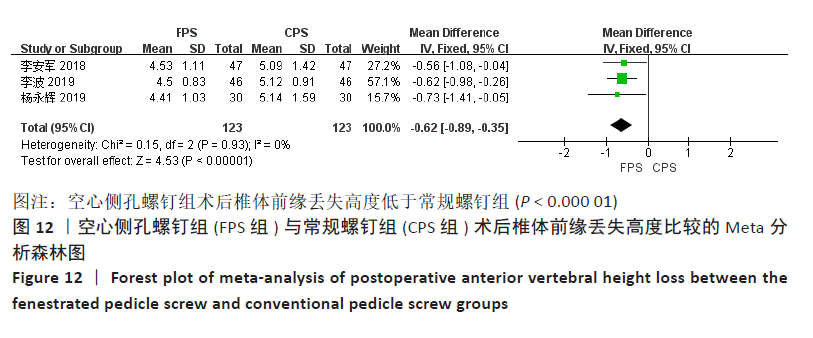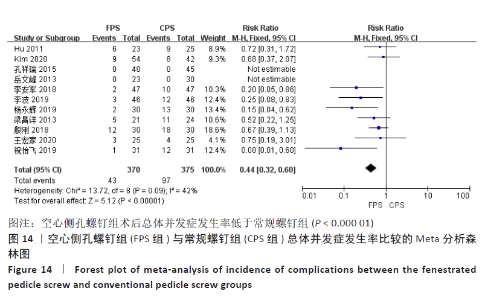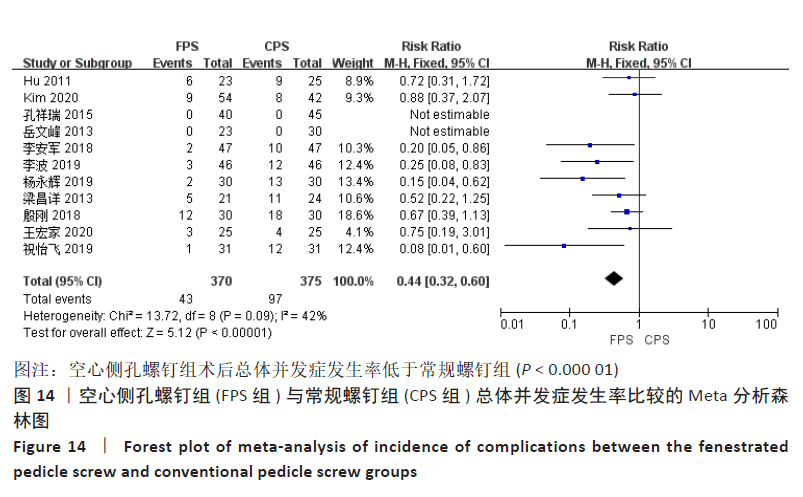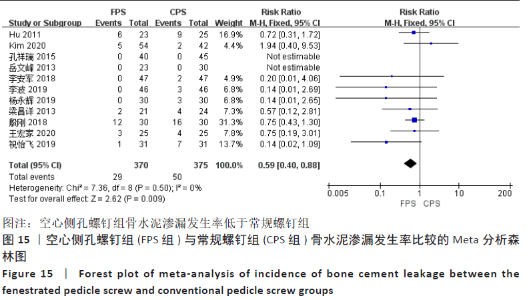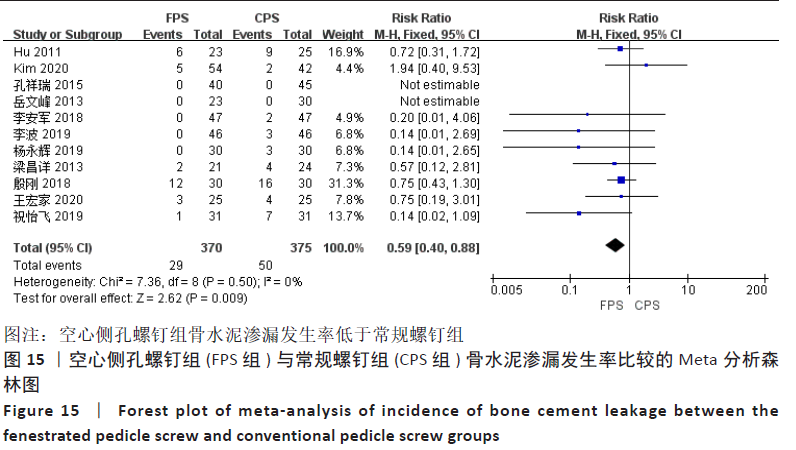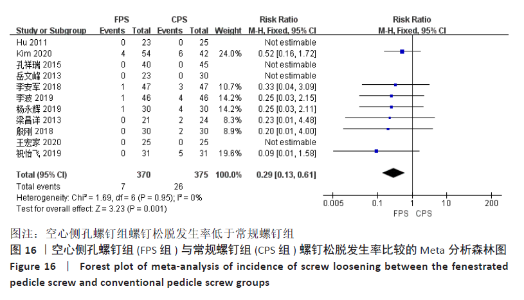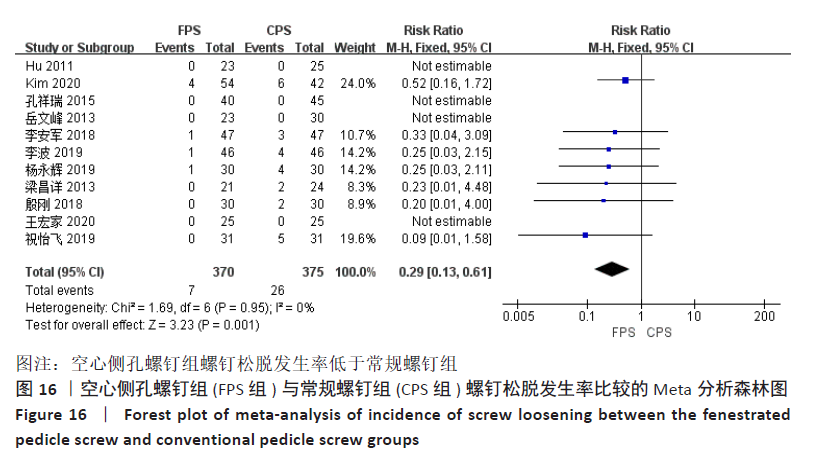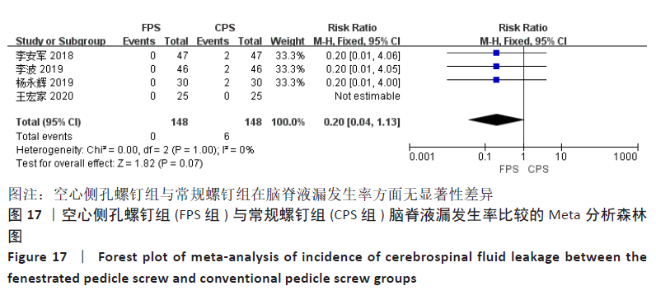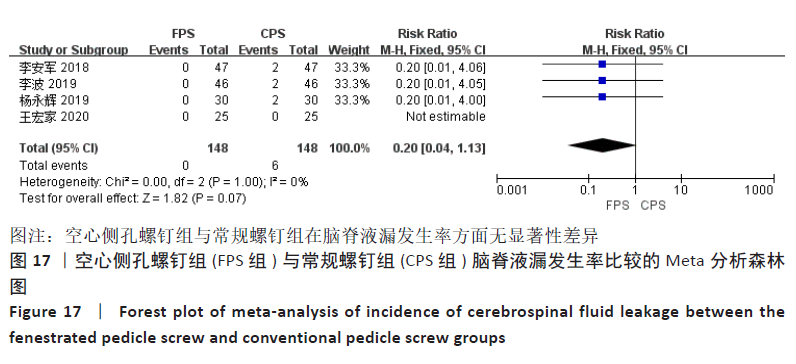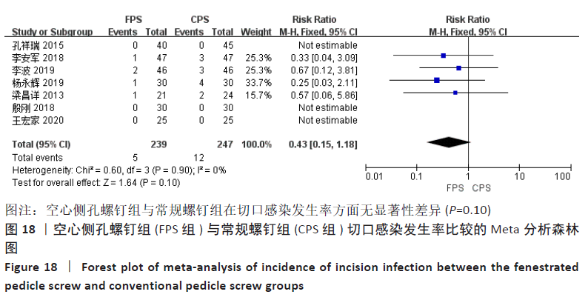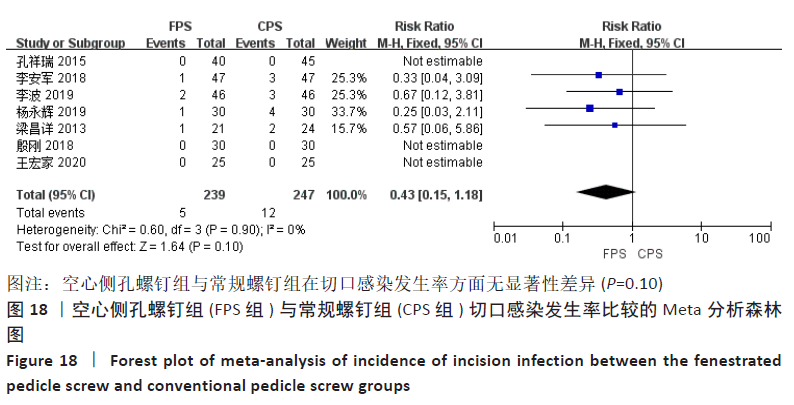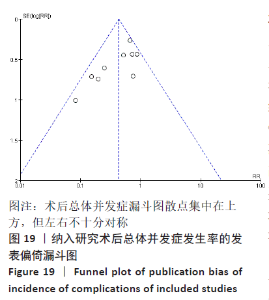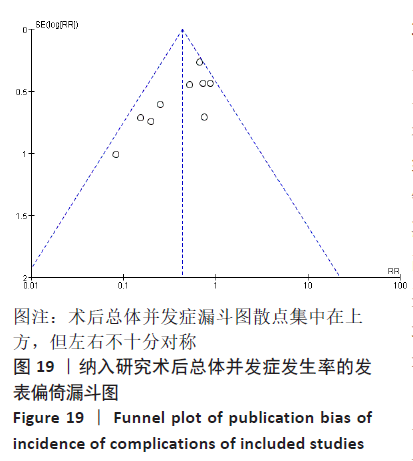Chinese Journal of Tissue Engineering Research ›› 2021, Vol. 25 ›› Issue (30): 4891-4899.doi: 10.12307/2021.279
Previous Articles Next Articles
Effects and safety of fenestrated and conventional pedicle screw combined with cement-augmentation in osteoporotic vertebral fixation: a meta-analysis
Guo Haiwei1, Xie Jiahao1, Lin Yanping2, Wang Yufeng3, Yang Qingqi4
- 1The Second Affiliated Medical College of Guangzhou University of Chinese Medicine, Guangzhou 510405, Guangdong Province, China; 2The Third Affiliated Medical College of Guangzhou University of Chinese Medicine, Guangzhou 510006, Guangdong Province, China; 3Guangdong Provincial Hospital of Chinese Medicine, Guangzhou 510120, Guangdong Province, China; 4Guangzhou Medical University, Guangzhou 511436, Guangdong Province, China
-
Received:2021-01-21Revised:2021-01-23Accepted:2021-02-18Online:2021-10-28Published:2021-07-29 -
Contact:Wang Yufeng, MD, Master’s supervisor, Associate chief physician, Guangdong Provincial Hospital of Chinese Medicine, Guangzhou 510120, Guangdong Province, China -
About author:Guo Haiwei, Master candidate, Physician, The Second Affiliated Medical College of Guangzhou University of Chinese Medicine, Guangzhou 510405, Guangdong Province, China -
Supported by:Research Project for Practice Development of National TCM Clinical Research Bases, No. JDZX2015081 (WYF)
CLC Number:
Cite this article
Guo Haiwei, Xie Jiahao, Lin Yanping, Wang Yufeng, Yang Qingqi. Effects and safety of fenestrated and conventional pedicle screw combined with cement-augmentation in osteoporotic vertebral fixation: a meta-analysis[J]. Chinese Journal of Tissue Engineering Research, 2021, 25(30): 4891-4899.
share this article
Add to citation manager EndNote|Reference Manager|ProCite|BibTeX|RefWorks
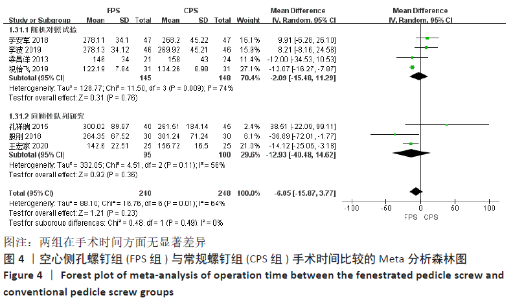
2.4 Meta分析结果 2.4.1 各组手术时间、术中出血量及住院时间差异 有7项研究报告了手术时间[12-16,19,21],各研究之间存在较大异质性(P=0.01,I2=64%),采用随机效应模型进行Meta分析,结果显示:两组之间的手术时间差异无显著性意义(MD=-6.05,95%CI:-15.87-3.77,P=0.23),按照不同研究类型进行亚组分析,4项随机对照试验合并结果显示两组手术时间差异无显著性意义(MD=-2.09,95%CI:-15.48-11.29,P=0.76) [13-15, 21],3项回顾性队列研究合并结果显示两组手术时间比较亦无显著性意义(MD=-12.93,95%CI:-40.48-14.62,P=0.36)[12, 16,19],见图4。"
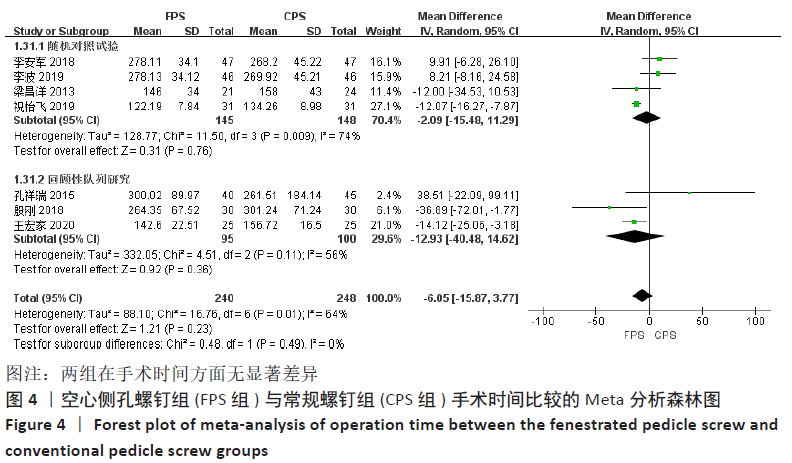
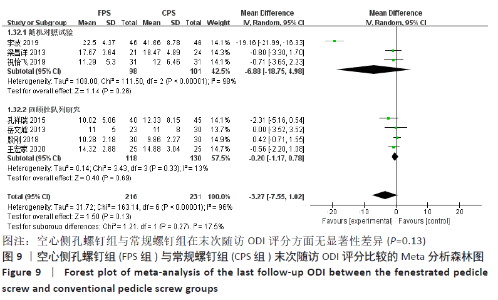
有7项研究比较了末次随访ODI评分[12,14-16,19-21],两组术前ODI评分无显著性差异(P=0.92),各研究之间有显著异质性(P < 0.000 01,I2=96%),采用随机效应模型进行Meta分析,结果显示:两组末次随访ODI评分差异无显著性意义(MD= -3.27,95%CI:-7.55-1.02,P=0.13),按不同研究类型进行亚组分析,3项随机对照试验合并结果显示,两组末次随访ODI评分差异无显著性意义(MD=-6.88,95%CI:-18.75-4.98,P=0.26) [14-15,21],4项回顾性队列研究合并结果显示,两组末次随访ODI评分亦差异无显著性意义(MD=-0.20,95%CI:-1.17-0.78,P=0.33) [12,16,19-20],见图9。"
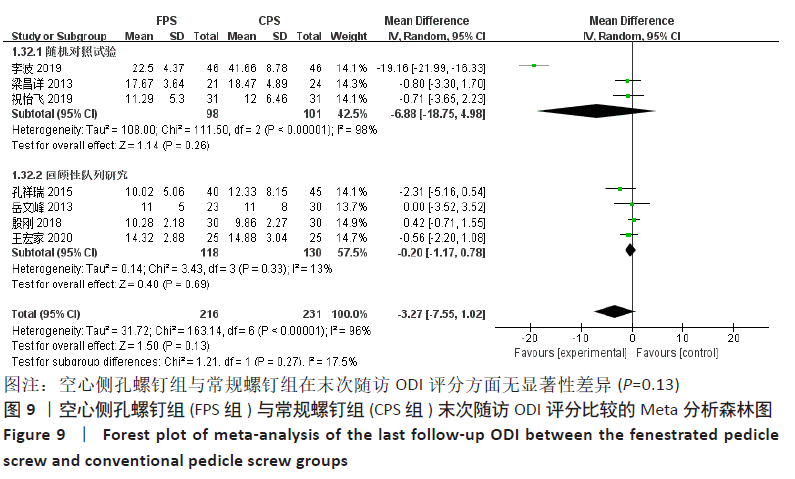
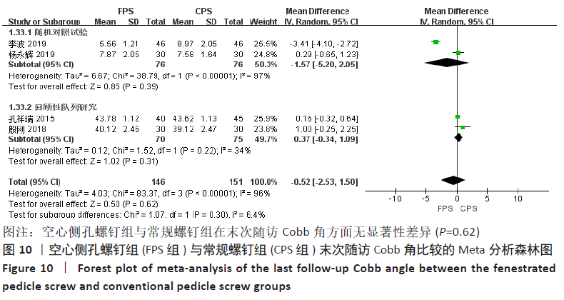
2.4.3 各组影像学结果参数差异 有4项研究比较了末次随访Cobb角[12,14,18-19], 两组间术前Cobb角无显著性差异(P=0.48),各研究之间存在显著异质性 (P < 0.000 01,I2=96%),采用随机效应模型进行Meta分析,结果显示:两组的末次随访Cobb角差异无显著性意义(MD= -0.52,95%CI:-2.53-1.50,P=0.62),按不同研究类型进行亚组分析,有2项随机对照试验合并结果显示两组间末次随访Cobb角无显著性差异(MD=-1.57,95%CI:-5.20-2.05,P=0.39) [14, 18],有2项回顾性队列研究合并结果显示两组间末次随访Cobb角无显著性差异(MD= 0.37,95%CI:-0.34-1.09,P=0.31) [12, 19],见图10。"
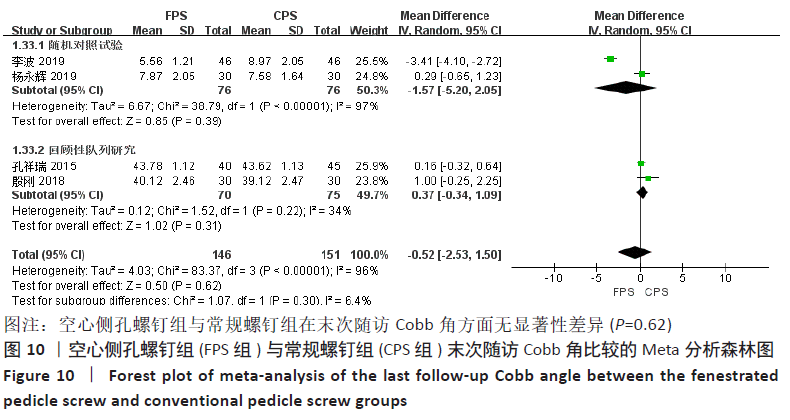
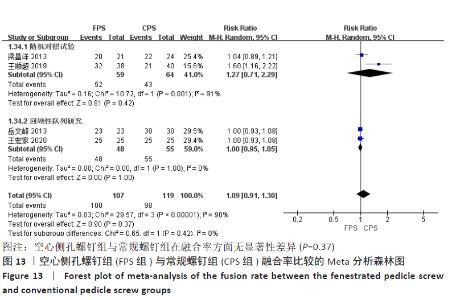
有4项研究比较了随访6个月以上的融合率[15-17,20],空心侧孔螺钉组融合率为93.46%,常规螺钉组融合率为82.35%。各研究间存在显著异质性(P < 0.000 01,I2=90%),采用随机效应模型进行Meta分析,结果显示,两组间差异无显著性意义(MD=1.09,95%CI:0.91-1.30,P=0.37),按不同研究类型进行亚组分析,2项随机对照试验合并结果显示,两组间融合率无显著性差异(MD=1.27,95%CI:0.71-2.29,P=0.42) [15,17],2项回顾性队列研究合并结果显示,两组间融合率无显著性差异(MD=1.00,95%CI:0.95-1.05,P=1.00) [16,20],见图13。"
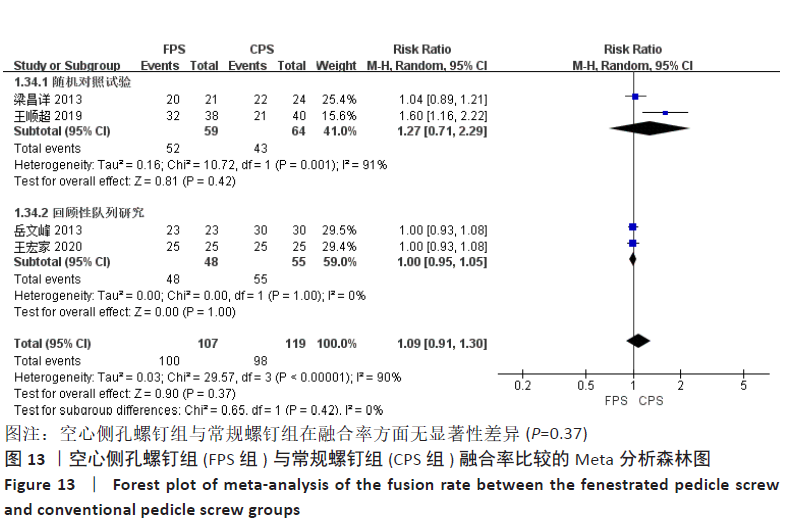
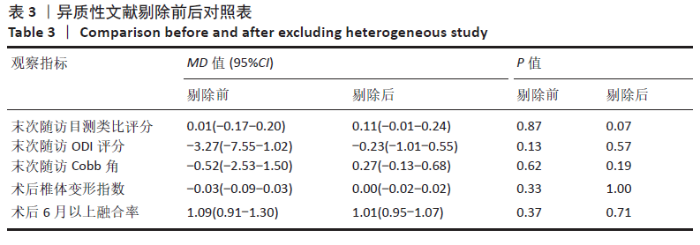
2.5 敏感性分析结果 对于手术时间进行敏感性分析,逐一剔除研究后重新进行合并分析,发现异质性未发生显著变化,且两组间比较均无显著性意义,提示Meta分析结果稳定可靠。考虑不同研究者对于手术时间的衡量标准不同以及手术医生的熟练程度均可能影响手术时间,导致研究间异质性较大。 对于末次随访目测类比评分,敏感性分析提示1项研究可能为此指标异质性来源[16],剔除该项研究后结果呈现为无异质性(I2=0%),但两组间比较仍无显著性意义(P=0.07),提示Meta分析结果相对稳定可靠。异质性可能是不同医师对于术后患者的疼痛管理方案不同,如应用止痛药的时间及强度等差异造成。 对于末次随访ODI评分,敏感性分析提示1项研究可能为异质性来源[14], 剔除该项研究后结果呈现为无异质性(I2=0%),但两组间比较仍无显著性意义(P=0.57),提示Meta分析结果相对稳定可靠。其原因主要为该研究中患者术前ODI评分明显高于其他研究的患者,在改善率相近情况下,术后ODI评分仍较高。 对于末次随访Cobb角,敏感性分析提示1项研究可能为异质性来源[14],剔除该项研究后结果呈现为无异质性(I2=0%),但两组间比较仍无显著性意义(P=0.62),提示Meta分析结果相对稳定可靠。考虑到固定节段位置及数量的不同导致Cobb角大小的差异,可能造成研究间的异质性。 对于术后椎体变形指数进行敏感性分析,剔除1项研究后结果呈现为无异质性(I2=0%)[19],但两组间比较仍无显著性意义(P=1),提示Meta分析结果相对稳定可靠。椎体变形指数等参数的测量需依赖于X射线片,且成像质量、拍摄角度、测量方式及测量者个人能力均可影响测量数据,这可能是造成上述研究为异质性来源的原因。 对于术后6个月以上融合率进行敏感性分析,剔除1项研究后结果呈现为无异质性(I2=0%)[17],但两组间比较仍无显著性意义(P=0.71),提示Meta分析结果相对稳定可靠。在融合情况评价方面,CT的精确度高于X射线片,但X射线片经济快捷,故仍为首选的检查方式。上述研究随访时间虽长达1年,但融合率明显低于其他3项研究,考虑其他3项研究均采用X射线片进行评价,而该项研究可能采用了CT检查评价融合情况,从而造成研究间异质性较大。 剔除异质性来源文献前后的效应量可信区间及P值见表3。"
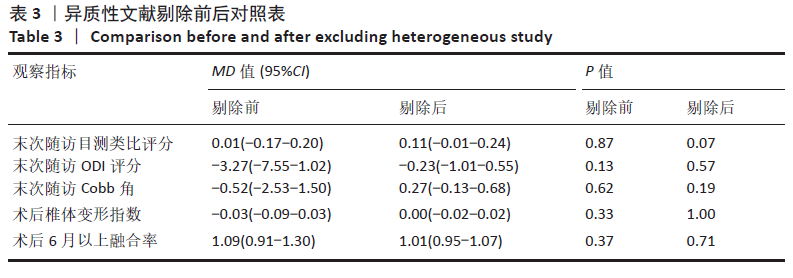
| [1] SOZEN T, OZISIK L, BASARAN NC. An overview and management of osteoporosis. Eur J Rheumatol. 2017;4(1):46-56. [2] 马远征,王以朋,刘强,等.中国老年骨质疏松症诊疗指南(2018)[J].中国骨质疏松杂志,2018, 24(12):1541-1567. [3] ROBERTO G, KONSTANTINOS P, MARCELO G, et al. Minimally invasive spinal fixation in an aging population with osteoporosis: clinical and radiological outcomes and safety of expandable screws versus fenestrated screws augmented with polymethylmethacrylate. Neurosurg Focus. 2020;49(2):E14. [4] KIM DY, KIM JR, JANG KY, et al. Evaluation of Titanium-Coated Pedicle Screws: In Vivo Porcine Lumbar Spine Model. World Neurosurg. 2016;91:163-1671. [5] DELGADO-FERNANDEZ J, GARCíA-PALLERO M, BLASCO G, et al. Review of Cortical Bone Trajectory: Evidence of a New Technique. Asian Spine J. 2017;11(5):817-831. [6] CHANDRA VV, PRASAD BC, JAGADEESH MA, et al. Segmental polymethylmethacrylate-augmented fenestrated pedicle screw fixation for lumbar spondylolisthesis in patients with osteoporosis - A case series and review of literature. Neurol India. 2017;65(1):89-95. [7] CHAO KH, LAI YS, CHEN WC, et al. Biomechanical analysis of different types of pedicle screw augmentation: a cadaveric and synthetic bone sample study of instrumented vertebral specimens. Med Eng Phys. 2013;35(10):1506-1512. [8] MARIE-HARDY L, PASCAL-MOUSSELLARD H, BARNABA A, et al. Screw loosening in posterior spine fusion: prevalence and risk factors. Global Spine J. 2020;10(5):598-602. [9] HOPPE S, KEEL MJ. Pedicle screw augmentation in osteoporotic spine: indications, limitations and technical aspects. Eur J Trauma Emerg Surg. 2017;43(1):3-8. [10] DASH A, BRINSTER DR. Open heart surgery for removal of polymethylmethacrylate after percutaneous vertebroplasty. Ann Thorac Surg. 2011;91(1):276-278. [11] GUO HZ, TANG YC, GUO DQ, et al. The cement leakage in cement-augmented pedicle screw instrumentation in degenerative lumbosacral diseases: a retrospective analysis of 202 cases and 950 augmented pedicle screws. Eur Spine J. 2019;28(7):1661-1669. [12] 孔祥瑞,杨计策,刘德政,等.常规椎弓根螺钉与新型可灌注椎弓根螺钉固定术联合聚甲基丙烯酸甲酯骨水泥的疗效对照评价 [J]. 现代医学, 2015,43(2):165-168. [13] 李安军,卜志勇,杨祖清.不同方式骨水泥强化椎弓根螺钉治疗老年骨质疏松性胸腰椎骨折的效果 [J]. 实用老年医学,2018,32(2):130-133. [14] 李波,马航展,黄海珊.两种方式骨水泥强化椎弓根螺钉对老年骨质疏松性胸腰椎骨折治疗效果及神经功能的影响 [J].中国当代医药,2019, 26(19):119-121. [15] 梁昌详,詹世强,柯雨洪,等.PMMA增强的多孔中空椎弓根螺钉治疗腰椎退变性疾病的疗效和安全性[J].中国脊柱脊髓杂志,2013,23(11): 984-988. [16] 王宏家,孟祥凤,田野,等.骨水泥预先灌注椎弓根螺钉和骨水泥强化椎弓根螺钉在腰椎退行性病变合并严重骨质疏松症的效果比较 [J].中国保健营养,2020,30(10):4-5. [17] 王顺超.可注射骨水泥型椎弓根螺钉对脊柱退变性疾病的疗效分析[J].系统医学,2019,4(17): 88-90. [18] 杨永辉,孙厚杰,王翀,等.椎弓根螺钉经钉尾灌注骨水泥固定术治疗胸腰椎骨折的效果观察 [J].北京医学,2019,41(4):321-323. [19] 殷刚,朱建国,杨雷,等.不同方式下骨水泥强化椎弓根螺钉固定手术治疗伴骨质疏松症腰椎退变性疾病的疗效对比 [J]. 颈腰痛杂志,2018, 39(4):412-415. [20] 岳文峰,夏虹,王建华.骨水泥强化椎弓根螺钉固定对骨质疏松患者有利无弊? [J]. 中国组织工程研究,2013,17(17):3081-3088. [21] 祝怡飞,张明生,王源基,等.骨水泥强化空心侧孔椎弓根螺钉在退行性腰椎手术中的应用研究 [J].中国实用医刊,2019,46(10):63-65. [22] HU MH, WU HT, CHANG MC, et al. Polymethylmethacrylate augmentation of the pedicle screw: the cement distribution in the vertebral body. Eur Spine J. 2011;20(8):1281-1288. [23] KIM JH, AHN DK, SHIN WS, et al. Clinical effects and complications of pedicle screw augmentation with bone cement: comparison of fenestrated screw augmentation and vertebroplasty augmentation. Clin Orthop Surg. 2020;12(2):194-199. [24] 高明暄,周胜虎,邓晓文,等.骨质疏松对椎弓根螺钉稳定性影响的实验研究[J].中国骨质疏松杂志,2013,19(1):39-42. [25] TOLUNAY T, BAŞGüL C, DEMIR T, et al. Pullout performance comparison of pedicle screws based on cement application and design parameters. Proc Inst Mech Eng H. 2015;229(11):786-793. [26] GüLER UO, DERINCEK A, HERSEKLI MA, et al. Restoration of pull-out strength of the failed pedicle screw: biomechanical comparison of calcium sulfate vs polymethylmethacrylate augmentation. Acta Orthop Traumatol Turc. 2014; 48(2):202-206. [27] BECKER S, CHAVANNE A, SPITALER R, et al. Assessment of different screw augmentation techniques and screw designs in osteoporotic spines. Eur Spine J. 2008;17(11):1462-1469. [28] CHANG MC, KAO HC, YING SH, et al. Polymethylmethacrylate augmentation of cannulated pedicle screws for fixation in osteoporotic spines and comparison of its clinical results and biomechanical characteristics with the needle injection method. J Spinal Disord Tech. 2013;26(6):305-315. [29] FRANSEN P. Increasing pedicle screw anchoring in the osteoporotic spine by cement injection through the implant. Technical note and report of three cases. J Neurosurg Spine. 2007;7(3):366-369. [30] 马江卫,刘烈东,杜耿, 等.新型设计可灌注骨水泥椎弓根螺钉的生物力学特性[J]. 中国组织工程研究,2015,19(34):5423-5427. [31] CLARK W, BIRD P, GONSKI P, et al. Safety and efficacy of vertebroplasty for acute painful osteoporotic fractures (VAPOUR): a multicentre, randomised, double-blind, placebo-controlled trial. Lancet. 2016;388(10052):1408-1416. [32] LAI PL, TAI CL, CHEN LH, et al. Cement leakage causes potential thermal injury in vertebroplasty. BMC Musculoskelet Disord. 2011;12:116. [33] DEMIRAYAK M, ŞIŞMAN L, TüRKMEN F, et al. Clinical and radiological results of microsurgical posterior lumbar interbody fusion and decompression without posterior instrumentation for lateral recess stenosis. Asian Spine J. 2015;9(5): 713-720. |
| [1] | Ouyang Beiping, Ma Xiangyang, Luo Chunshan, Zou Xiaobao, Lu Tingsheng, Chen Qiling. Three-dimensional finite element analysis of a new horizontal screw-screw crosslink in posterior atlantoaxial internal fixation [J]. Chinese Journal of Tissue Engineering Research, 2024, 28(9): 1320-1324. |
| [2] | Guo Sutong, Feng Dehong, Guo Yu, Wang Ling, Ding Yujian, Liu Yi, Qian Zhengying, Li Mingyang. Construction and finite element analysis of normal and osteoporotic hip models [J]. Chinese Journal of Tissue Engineering Research, 2024, 28(9): 1342-1346. |
| [3] | Niu Hegang, Yang Kun, Zhang Jingjing, Yan Yizhu, Zhang Yinshun. Design of a new posterior atlas fracture reduction and internal fixation system [J]. Chinese Journal of Tissue Engineering Research, 2024, 28(9): 1399-1402. |
| [4] | Wang Menghan, Qi Han, Zhang Yuan, Chen Yanzhi. Three kinds of 3D printed models assisted in treatment of Robinson type II B2 clavicle fracture [J]. Chinese Journal of Tissue Engineering Research, 2024, 28(9): 1403-1408. |
| [5] | Zhong Jun, Wang Wen. Network meta-analysis of different anatomical repair strategies to improve chronic lateral ankle instability [J]. Chinese Journal of Tissue Engineering Research, 2024, 28(9): 1470-1476. |
| [6] | Zhang Xiaoyun, Liu Hua, Chai Yuan, Chen Feng, Zeng Hao, Gao Zhengang, Huang Yourong. Effect of Yishen Gushu Formula on bone metabolic markers and clinical efficacyn in patients with osteoporosis of kidney deficiency and blood stasis type [J]. Chinese Journal of Tissue Engineering Research, 2024, 28(8): 1155-1160. |
| [7] | Dai Yuexing, Zheng Liqin, Wu Minhui, Li Zhihong, Li Shaobin, Zheng Desheng, Lin Ziling. Effect of vessel number on computational fluid dynamics in vascular networks [J]. Chinese Journal of Tissue Engineering Research, 2024, 28(8): 1206-1210. |
| [8] | Ma Shuwei, He Sheng, Han Bing, Zhang Liaoyun. Exosomes derived from mesenchymal stem cells in treatment of animals with acute liver failure: a meta-analysis [J]. Chinese Journal of Tissue Engineering Research, 2024, 28(7): 1137-1142. |
| [9] | Wang Qiang, Li Shiyun, Xiong Ying, Li Tiantian. Biomechanical changes of the cervical spine in internal fixation with different anterior cervical interbody fusion systems [J]. Chinese Journal of Tissue Engineering Research, 2024, 28(6): 821-826. |
| [10] | Zhang Min, Peng Jing, Zhang Qiang, Chen Dewang. Mechanical properties of L3/4 laminar decompression and intervertebral fusion in elderly osteoporosis patients analyzed by finite element method [J]. Chinese Journal of Tissue Engineering Research, 2024, 28(6): 847-851. |
| [11] | Xue Xiaofeng, Wei Yongkang, Qiao Xiaohong, Du Yuyong, Niu Jianjun, Ren Lixin, Yang Huifeng, Zhang Zhimin, Guo Yuan, Chen Weiyi. Finite element analysis of osteoporosis in proximal femur after cannulated screw fixation for femoral neck fracture [J]. Chinese Journal of Tissue Engineering Research, 2024, 28(6): 862-867. |
| [12] | Zheng Jiafa, Song Xiufeng, Li Hongzhi, Zhou Jinming, Guan Shengyi, Yu He. Open reduction and internal fixation via the para-Achilles tendon approach for the treatment of posterior malleolus sandwich fractures [J]. Chinese Journal of Tissue Engineering Research, 2024, 28(6): 934-938. |
| [13] | Kaiyisaier•Abudukelimu, Maimaitimin•Abulimiti, Li Lei, Yang Xiaokai, Zhang Yukun, Liu Shuai. Effect of lumbar CT values in the diagnosis of osteoporosis in women patients with lumbar degenerative diseases [J]. Chinese Journal of Tissue Engineering Research, 2024, 28(6): 945-949. |
| [14] | Wang Liping, Lian Tianxing, Hu Yongrong, Yang Hongsheng, Zeng Zhimou, Liu Hao, Qu Bo. HU value of chest CT vertebral body in the opportunistic screening of type 2 diabetes mellitus osteoporosis [J]. Chinese Journal of Tissue Engineering Research, 2024, 28(6): 950-954. |
| [15] | Zhang Zeyi, Yang Yimin, Li Wenyan, Zhang Meizhen. Effect of foot progression angle on lower extremity kinetics of knee osteoarthritis patients of different ages: a systematic review and meta-analysis [J]. Chinese Journal of Tissue Engineering Research, 2024, 28(6): 968-975. |
| Viewed | ||||||
|
Full text |
|
|||||
|
Abstract |
|
|||||
